Local SEO refers to optimization efforts made to improve a business’s visibility and rankings in local search engine results. This includes results on Google Maps, local listings, and other location-based searches. Local SEO is extremely important for businesses that offer products or services in a specific geographic area, such as restaurants, retail stores, plumbers, lawyers etc. Higher visibility in local searches allows these businesses to effectively target nearby customers and drive more foot traffic.
With the steady rise of mobile device usage, an increasing chunk of organic searches are performed with location data or intent. According to statistics, over 46% of all Google searches have local intent. This highlights the growing relevance of local SEO in 2024. Optimizing for local searches can generate more relevant website traffic and increase conversion rates.
Local SEO practices have evolved significantly from just having a Google My Business listing. Some key developments include:
As search engines get better at understanding user context and locations, Local SEO practices continue to be shaped to align with it.
Here are some key reasons why local SEO should be a priority for businesses in 2024:
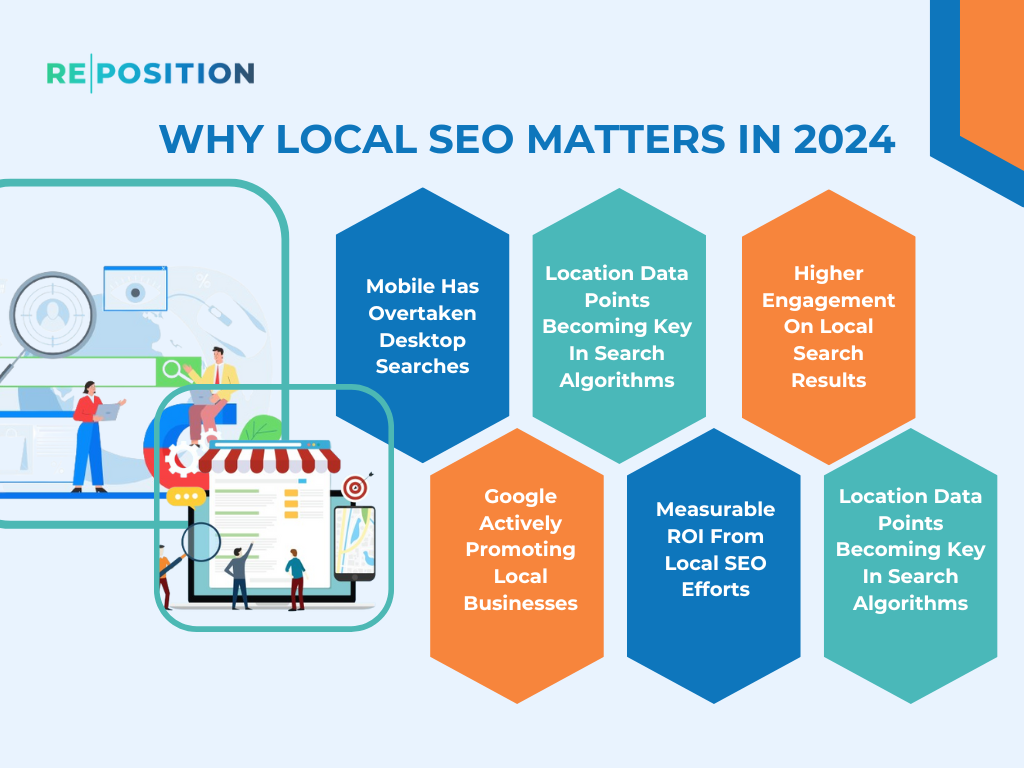
Mobile Has Overtaken Desktop Searches
Mobile devices now account for maximum online searches, compared to around 40% coming from desktops. The nature of searches on mobile also tends to be more local and immediate, with users expecting information on the go regarding businesses in their vicinity. Mobile searches related to products or services happen in the buyer’s micro-moment when they have an immediate need. Optimizing for local mobile searches helps businesses tap into this intent-filled traffic.
Location Data Points Becoming Key In Search Algorithms
Search engines, especially Google, have steadily refined their ability to parse location signals from mobile searches. Key data points like device location, local keywords, business attributes, and proximity – play an important role in ranking localized search results on Maps and organic listings. Recent updates like Google My Business profile integration also indicate the growing influence of location metadata.
Higher Engagement On Local Search Results
Listings that show up on the Local Finder pack tend to enjoy much higher CTRs compared to regular organic results. When users search for something like “Chinese restaurant nearby”, they expect to see relevant information about dining options close to them. The localized nature of the results leads to higher engagement. According to Moz, Local Finder pack results get around 35% of the total clicks while taking up much smaller screen space.
Google Actively Promoting Local Businesses
To improve the local search experience, Google actively bumps up relevance and ratings of trusted local businesses. This manifests through better visibility in the Local Finder pack, locator pins on Maps, promotional inserts like “order online” buttons etc. Maintaining robust Local SEO strengthens a business’ merit. This increases the likelihood of appearing among the promoted search results for relevant keywords.
Measurable ROI From Local SEO Efforts
Unlike vague brand-related SEO, investments towards local search optimization guarantee measurable ROI. Businesses can track online visits, calls, direction requests and most crucially – location-specific conversions driven by Local SEO. Since the audience is geographically targeted, analytics help assess sales impact by city or region. The numbers help businesses calculate the actual return from local SEO.
Drives Both Online And Offline Sales
Ranking higher among local search results increases the chances of sales through the website and offline channels. Website visitors derived from location-specific keywords already have buying intent primed through their search query. Additionally, search prominence also drives extra brand awareness and foot traffic from people in the area. This compounds the overall business revenue.
With voice searches also gaining steady momentum, they will start playing a pivotal role in 2024. To conclude, sharpening Local SEO tactics should now be a strategic investment for geography and location-based businesses rather than just an operational focus area.
As more and more searches carry local intent, ranking higher in localized SERP has become vital for businesses to gain visibility. The priority elements that influence local search rankings can be broken down into three core categories:
On-page optimization refers to the website updates done to improve the local SEO merit of individual site pages, including optimizing with relevant local keywords, mentions of location details, and geo-tagged images.
Off-page optimization focuses on earning external signals like citations on directories, links from local sites, and social media engagement to reinforce the localized relevance of the business.
Technical onsite enhancements like implementing schema markup to structure location data, optimizing site architecture and ensuring mobile responsiveness help search engines better understand the local context and improve crawlability.
Gaining a firm grasp of these key local SEO ranking factors is essential for geography-specific businesses that want to improve their search visibility and tap into intent-based traffic from their respective locales. A strategic approach covering all three areas is key to sustainable high rankings.
On-Page Optimization For Local SEO
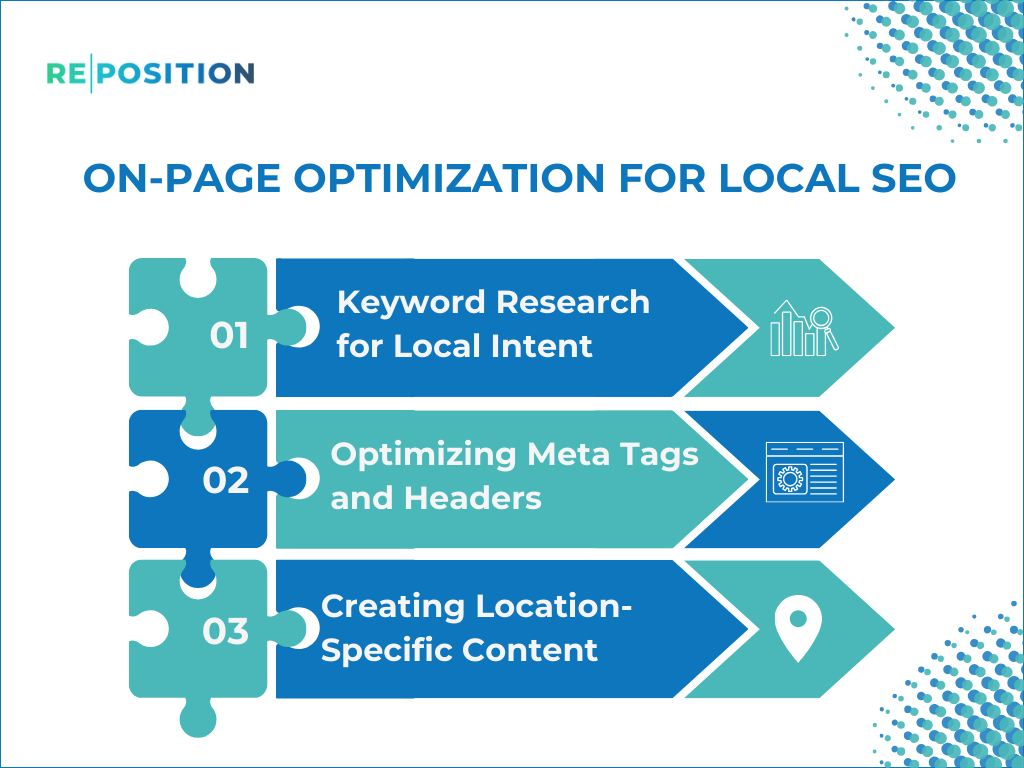
On-page optimization refers to the website updates done to improve the local SEO merit of individual site pages.
Off-Page Optimization For Local SEO
Off-page optimization focuses on earning citations, reviews, links and signals from external sources to boost local SEO.
Leveraging Social Signals for Local SEO Having strong local social media profiles that generate engagement also boosts search visibility.
Technical SEO For Local Businesses
This covers the technical website enhancements that help search engines understand the local context.
A combination of well-rounded on-page content, influential off-page signals and site structure optimizations is essential for good local SEO performance.
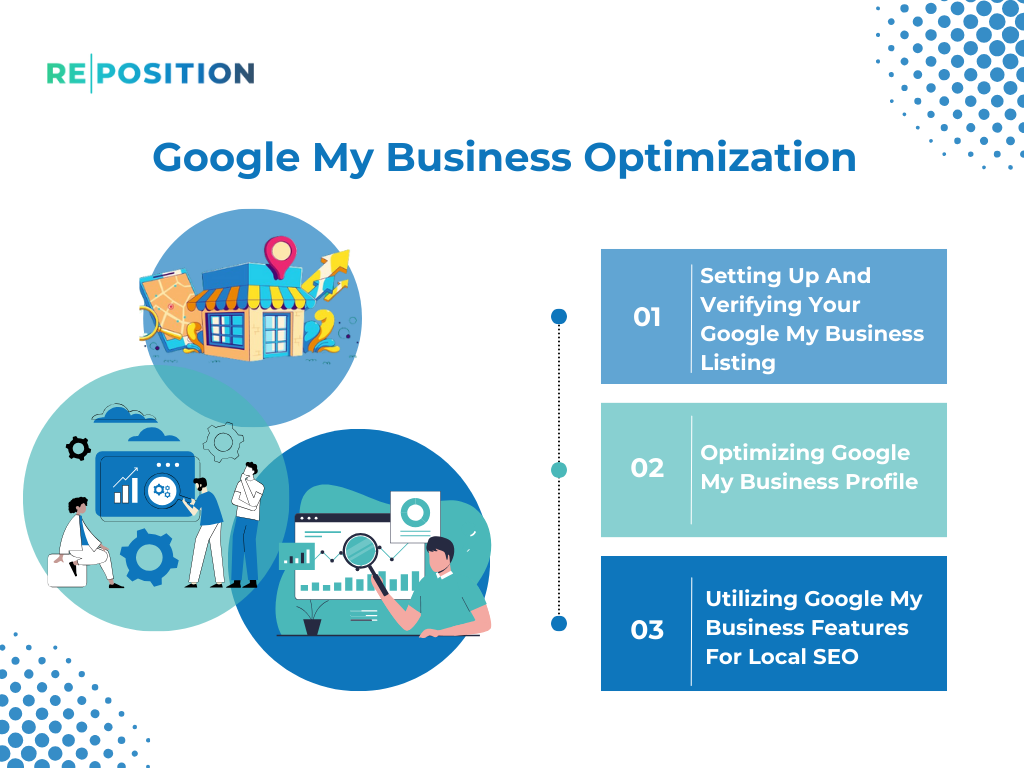
Google My Business listings have become vital for local SEO success by serving as a digital storefront for businesses in Google’s expansive search and maps ecosystem. Optimizing it strategically boosts discoverability and conversions from local searches.
Key elements for maximizing its impact include thoroughly filling out accurate business information, uploading engaging photos and videos to increase click-throughs, managing customer reviews to inspire trust, regularly posting updates to improve freshness and responding to user messages and queries to boost engagement.
Tracking analytics reports and trends provides useful insights to refine the GMB optimization strategy. A well-structured Google My Business profile that highlights the local relevance of the business enhances its merit in local algorithm ranking signals. This drives more high-converting traffic from localized organic and map searches, cementing its indispensability for Local SEO.
Here are the steps we need to take.
Setting Up And Verifying Your Google My Business Listing
The first step is to create or claim your GMB listing. Accurate information is provided for the business name, address, website, categories etc. Phone verification, postcard verification or email verification then confirms the listing ownership officially.
Optimizing Google My Business Profile
Adding Accurate Business Information – All the details regarding the business timings, offerings, FAQs etc. must be kept updated regularly. Location specifics like service area, floor number etc. help searches.
Uploading High-Quality Photos and Videos – Engaging & informative photos and videos of storefronts, products, offerings etc. improve click-throughs and conversions.
Managing Reviews and Ratings – Monitoring and responding appropriately to customer reviews builds brand reputation. Being responsive helps manage negative reviews too.
Utilizing Google My Business Features For Local SEO
Posts and Updates – Regular posts updating the latest offers or announcements ensure the listing stays fresh.
Messaging and Q&A – Responding quickly to leads and queries sent via GMB messaging or Q&A leads to higher engagement.
Insights and Analytics – Analytics reports provide data on searches, calls, direction requests, website visits etc. driven by the GMB listing. Monitoring key trends here offers guidance for optimization.
A regularly maintained Google My Business profile with rich content and information quality serves as a strong driver of local SEO success by improving search visibility.
While optimizing for local searches is imperative across all business types, the strategies require adaptation as per the on-ground and online commercial aspects. Brick-and-mortar stores need to drive more foot traffic to locations, service providers must showcase their offerings to the local audience, and retail chains need to optimize both in-store and online sales.
For physical stores, the focus should be on targeting high-intent local keywords, getting involved with community events, and creating an engaging in-location experience. Service businesses should highlight the areas they serve, enable online bookings, and prominently display reviews from local customers. E-commerce players need location-specific product pages, convenient delivery/pick-up options, and personalized local inventory ads.
The common thread is enhancing user experience for the local audience by easing access to information and offerings. But the channels and formats differ – offline for stores by driving visits, online for service providers by clear communication, and both for retail chains. Understanding these differences is key to shaping an effective localized strategy. The rewards are higher conversions and revenues from existing clientele.
Local SEO For Retail Stores And Offices
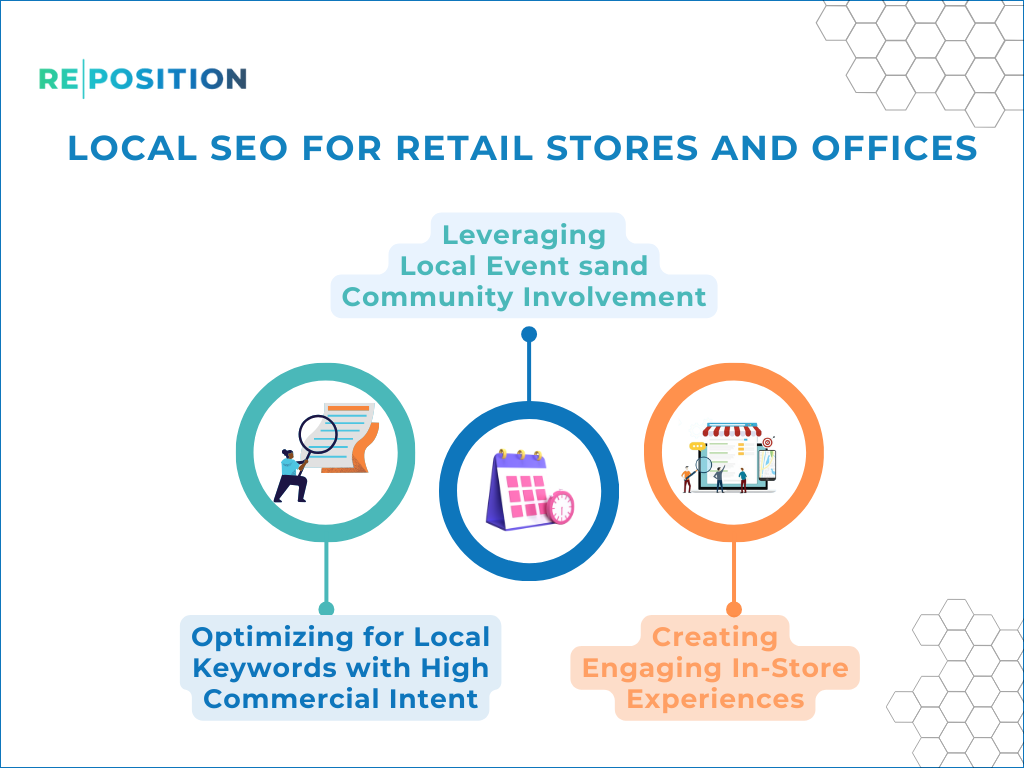
Brick-and-mortar retail stores strongly rely on neighborhood customers and foot traffic for their in-store sales. Since they cater to the residents and workers around the locations they serve, local SEO for such businesses should have the clear objective of driving more store visits within their geographic radius. Some ways to achieve this include:
Researching and targeting local keywords that indicate immediate purchase intent helps connect with customers ready to visit the store. For example, a bookstore would want to rank highly for searches like “bookstores in Concord” or “buy fiction books near me”. Such high commercial intent phrases reveal users actively looking to visit a bookstore.
Retail stores and offices can actively engage with local events, partnerships and community outreach programs to establish wider brand visibility and credibility within the neighborhoods they serve. Sponsoring a local fun fair, offering venue and resources for a book reading event, or volunteering resources for community drives helps endear the store to residents. This drives more organic awareness and footfall.
Taking the extra initiative to create fun, interactive and engaging experiences within the store also goes a long way in delighting customers and inspiring repeat local store visits. Special seasonal displays and events, contest exclusive merchandise available only in-store, complementary gift wrapping services etc. help entice more visits out of the local area’s demographic.
Local SEO For Service-Based Businesses
For service providers offering professional or technical services to local geographies like lawyers, dentists, tutors, electricians etc. – showcasing their offerings clearly to the intended audience online is crucial. Some effective approaches:
Having location pages or blogs highlighting the services offered specifically to different nearby regions helps reinforce expertise in local searches from those areas. For a plumber, this could mean having dedicated pages for areas they cover like “Emergency Plumbing Services in Newark, NJ” with locally optimized content.
Enabling instant and convenient booking by integrating online appointment scheduling and calendars makes the process of hiring service providers quicker and less cumbersome. Users searching for things like “teeth cleaning Lower East Side, New York” would prefer instantly booking an appointment.
Displaying positive detailed reviews and case studies from local customers helps put faces to work and builds familiarity. For example, a music teacher can highlight student testimonials or a family lawyer can showcase successful local cases. This establishes trust and expertise for the immediate community.
Local SEO for E-commerce Businesses with Physical Locations
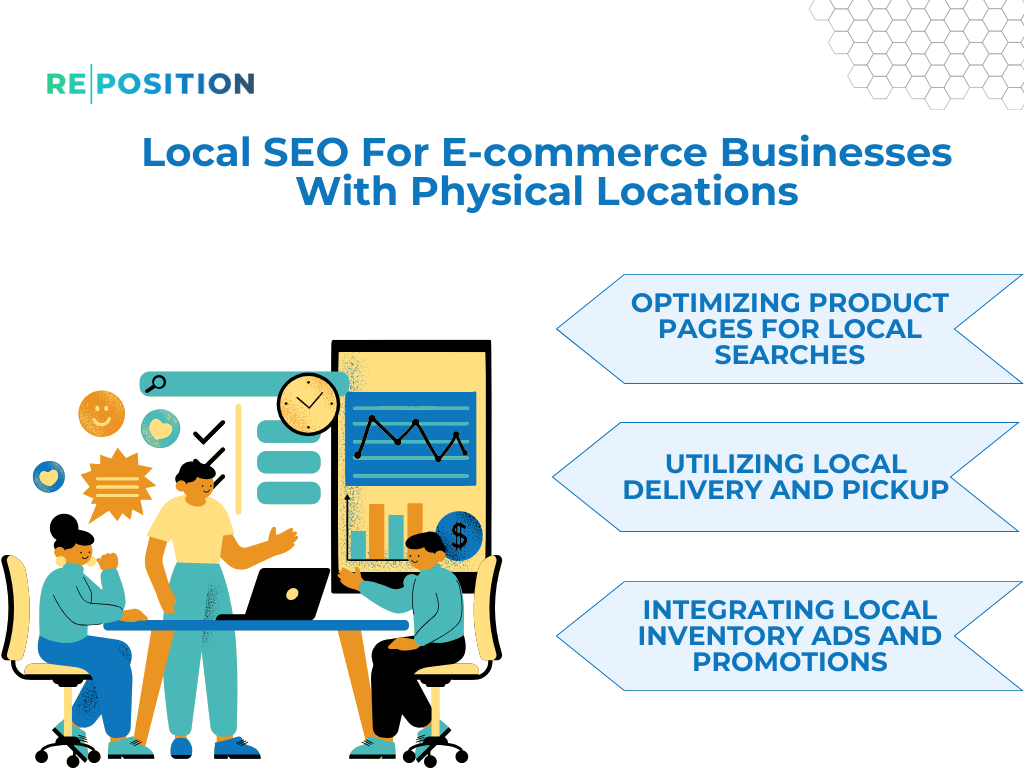
For retail chains with both online and physical store presence, optimizing for both channels is crucial. Some approaches include:
Having geo-targeted product pages or sections highlighting inventory availability, associated delivery costs, discounts and taxes for nearby store locations. This helps customers searching locally immediately find relevant catalog information.
Options Providing convenient localized delivery and store pickup options make buying from e-commerce retailers easier for local audiences. Integration of services like Shopify Local Delivery helps.
Location-specific ads and personalized promotions based on proximity to physical stores assist targeting. Retailers get to dynamically showcase relevant offers tailored to in-stock items across locations.
Optimizing user experience both digitally and physically as per the business type and locations is key for Local SEO success.
As consumer behavior shifts ever more towards localized online searching, developing your Local Search Engine Optimization (SEO) prowess has become pivotal for businesses to achieve visibility and gain new customers. While foundational technical SEO groundwork remains vital, increasingly advanced geo-targeted SEO tactics and novel ranking signal strategies also need incorporated into your localization efforts.
This comprehensive guide will help you dive deeper into crucial but often overlooked aspects of Local SEO optimization. The specialized localization topics beyond just basic schema markup and NAP consistency such as optimizing Google Business Profile categories, building localized links/citations and maximising positive community sentiment and review counts. Whether you are looking to improve website conversions via Google Maps 3-pack dominance or expand brand awareness through optimized area-relevant rich results, this manual will help equip you with insider competitive-edge local search tactics. So if you are serious about maximizing your digital visibility within high commercial-intent searchers close to your physical premises, now is the time to level up with these expert local SEO strategies.
Voice Search Optimization For Local Businesses
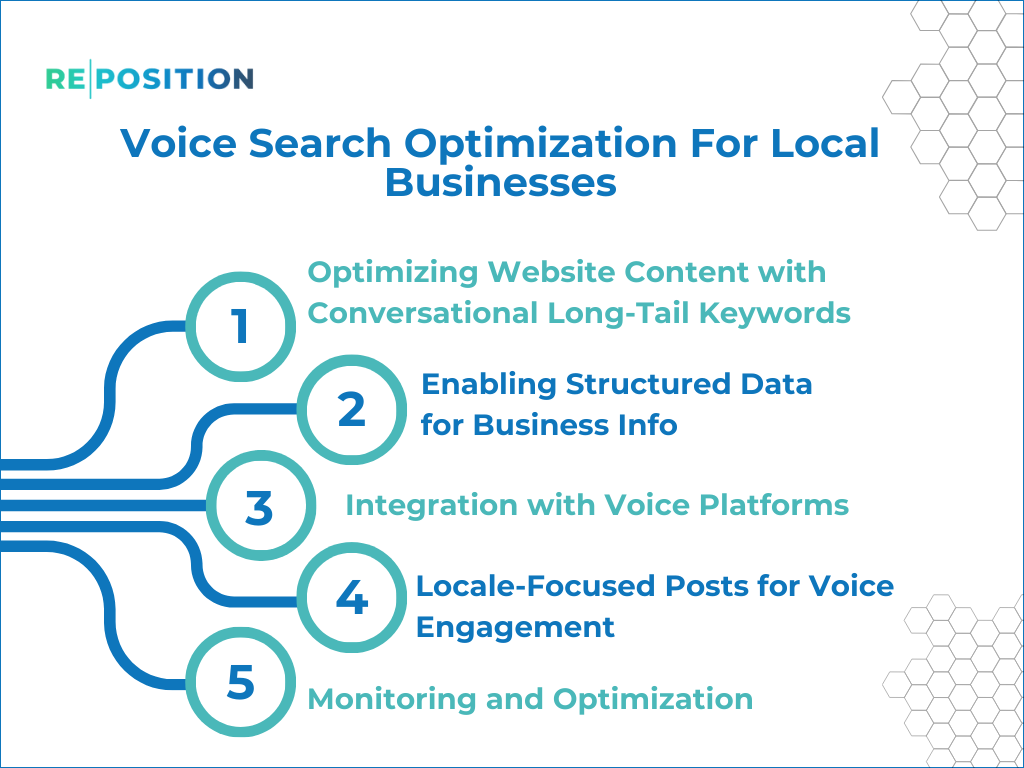
Voice-based interactions are radically transforming local search behaviors and emerging as a strategically important channel, especially for location-based inquiries. With the growing adoption of voice search via digital assistants like Alexa, Siri and Google Assistant– optimizing for voice should become an integral part of local SEO strategies in 2024.
Unlike text-based typing, voice searches are more natural, conversational and centered on quickly finding information. Local businesses must adapt their optimization playbook accordingly with a focus on discoverability and seamless access to information through voice search.
Optimizing Website Content with Conversational Long-Tail Keywords – Since voice queries are longer and more conversational like “Find good burger places open now near me”, website content must match accordingly. Researching and mapping relevant community-focused long tail keywords helps pages rank for natural speech search patterns.
Enabling Structured Data for Business Info – Search engines parse semantic data more accurately through structured markup. Details like business address, open hours, and contact info should be marked up using schema. This aids in voice results popping up the correct information.
Integration with Voice Platforms – Direct integration where possible with voice platforms like having a Google Business Profile directly accessible via Google Assistant provides a native search experience.
Locale-Focused Posts for Voice Engagement – Posts on the GMB listing can highlight limited-time offers or announcements that relate to engaging voice searches in the region for things like “events near me this weekend”.
Monitoring and Optimization – Tracking search analytics to identify rising community-driven voice queries and optimizing pages accordingly is key for localization over time. Voice is pivotal in the consumer journey for nearby offerings.
With mobile growth, voice emerging as a popular interface for localized searches. Tailoring content strategy and data structure accordingly strengthens the pathways for discovery and drives foot traffic.
Leveraging Local Influencers And Partnerships
Influential personalities, groups and organizations within a geographic region can be powerful conduits for establishing brand visibility and trust.
Some ideas to leverage them:
Harnessing The Power Of Geo-Targeted Advertising
Social media platforms now allow accurate targeting of ads by location radius along with contextual and behavioral signals. Retargeting visitors who searched locally can also power conversions.
Monitoring And Measuring Local SEO Performance
Tracking relevant key metrics is vital for gauging local SEO efforts and doubling down on what works.
Key Metrics to Track for Local SEO Success
Some key indicators include:
Tools and Platforms for Local SEO Analytics
Solutions like Google Analytics, Google Search Console, GMB Insights, Moz Local, Semrush etc. help gather intelligence.
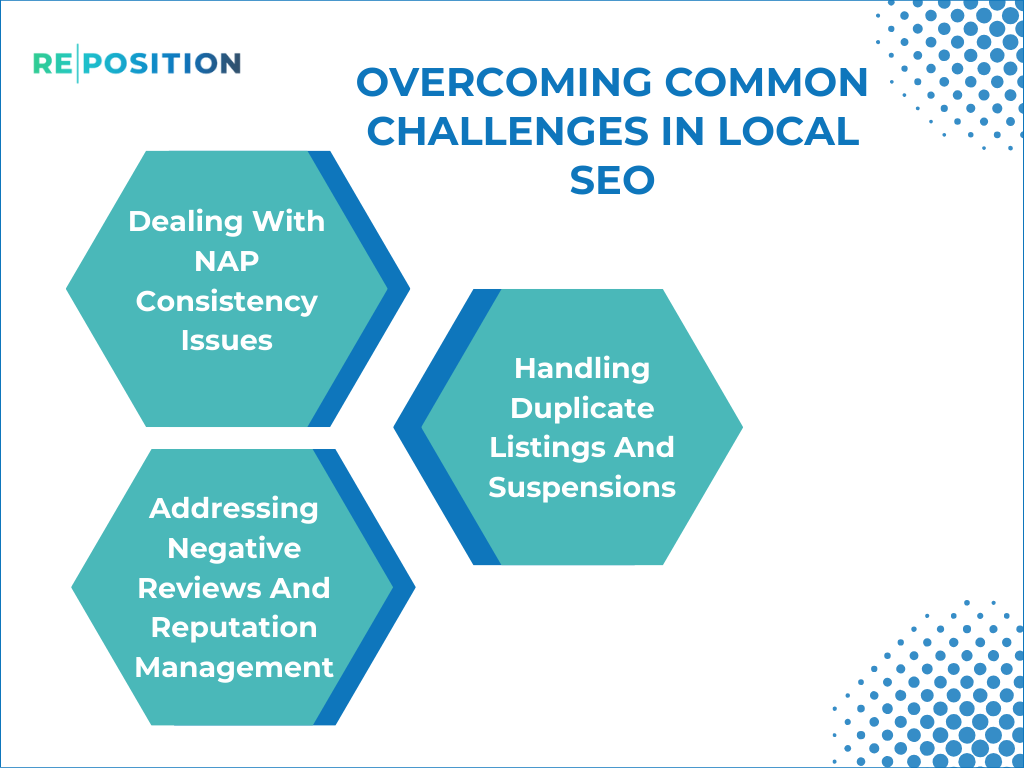
Mastering local search engine optimization comes with a unique set of obstacles beyond conventional organic SEO, from establishing online consistency across directory citations to generating substantial location-relevant authoritative signals.
However, by understanding core challenges and actively addressing each issue step-wise in turn, progress can happen swiftly. It is important to examine the most prevalent local SEO problems that impede map rankings and website visitor traffic, spanning technical to reputational realms.
There are solutions to conquer roadblocks like Google Business Profile suspension, duplicate GMB listings, review suppression censorship, lacking review volume plus local link-building struggles. Both quick fixes and longer-term resolution paths receive consideration so consistent localized visibility gains get solidified. Whether presently tackling a specific obstruction or wanting to preempt upcoming struggles within your geo-ranking journey, applying this comprehensive problem-solving framework will illuminate pathways to overcome almost any Local SEO challenge.
Implementing local SEO can have a unique set of challenges that need smart mitigation plans.
Dealing With NAP Consistency Issues
NAP refers to the Name, Address and Phone number of a business entity. Inconsistencies in the way this information appears online across review sites, listings, and citations can confuse search engines trying to understand the local relevance of the business. This ends up negatively impacting local SEO rankings and discoverability.
Fixing NAP inconsistencies should be a priority, and some effective ways brands can tackle this include
Staying vigilant against various sites showing different names, addresses or other information is pivotal to maintaining search engine trust signals. Streamlining this visibility through centralized database syncing should be an ongoing priority.
Handling Duplicate Listings And Suspensions
As a local business, it is common to have multiple outdated Google My Business listings created over the years without consolidating them. This creates duplicate profiles with divergent data across each. Besides diluting the overall signals to Google’s local algorithm, it also risks suspensions if some of these listings are found violating guidelines.
Here are some tips to effectively tackle duplicate listings and related suspensions:
Carefully managing Google My Business listings by weeding out duplicates and preventing policy-offending information fills key health signals. It helps sustain organic visibility by avoiding account suspensions. Here is a detailed overview of addressing negative reviews and online reputation management:
Addressing Negative Reviews And Reputation Management
Angry, vocal negative reviews and feedback online can be very damaging for local businesses if left unaddressed. They shape perceptions of potential customers via search and word-of-mouth. Having a robust online reputation management strategy and process is key.
Some best practices include:
Having systems to encourage positive advocacy and effectively address negativity is integral for managing brand reputation and conversions digitally. It pays rich dividends improving local search rankings and financial outcomes long-term.
Local SEO strategies will continue evolving parallelly with emerging search and consumer trends. Gaining foresight into upcoming shifts can direct efforts accordingly.
The Impact Of AI And Machine Learning On Local Search
AI and ML already help refine search algorithms with semantic nuances and personalized suggestion engines.
Their scope will expand further:
Emerging Technologies And Their Role In Local SEO
Cutting-edge technologies will shape information discoverability like:
Predictions For The Future Landscape Of Local SEO
Some potential developments include:
Businesses should balance long and short-term objectives complementarily while anticipating search advancements that elevate user experiences, convenience and decision intelligence for local discovery.
Local SEO has become pivotal in the marketing mix for geography-specific businesses targeting local communities. As mobile adoption and usage of digital assistants surge, local searches are becoming the dominant means of discovering information. Precision-based micro-moments now shape buying decisions.
Strategies thus need evolution beyond generic SEO to cater accurately to these intent-filled searches. Businesses must optimize holistically to be discoverable across channels where people find information locally — search engines, review sites, maps, social media, and increasingly through voice search.
Mastering the trifecta of on-page optimization, citation building and online reputation management will continue paying dividends driving organic visibility. But additional dimensions like localization of language via copywriting and customer service now play a pivotal role too enhancing experiences.
With machine learning and AI elevating the context parsing of searches, having technologies that help businesses continually optimize their pages dynamically to match will gain importance. Aggregating performance metrics across devices and channels provides comprehensive diagnostics to refine approaches.
The lookahead horizon of 2024 and beyond will see search engines further embed themselves across user journeys via wearables, spatial computing, and digital retail integrations — all relying heavily on accurate hyperlocal signals.
The market rewards now go to brands shaping experiences most aligned to convenience and personalization. Local SEO thus ceases to remain a siloed channel, instead becoming the very DNA of commercial user experience optimization now and in the future.